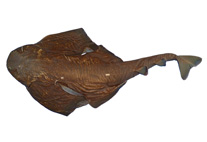Abstract
The morphology and taxonomy of species of Squatina from the southwestern Atlantic Ocean are revised. Species previously considered valid, Squatina argentina (Marini, 1930), Squatina guggenheim Marini, 1936 and Squatina occulta Vooren and da Silva, 1991, are investigated and described in detail, including a morphometric and meristic study of specimens from their recorded range. The taxonomic status of the doubtful nominal species Squatina punctata Marini, 1936 was also evaluated. This species was previously considered a junior synonym of S. argentina, a junior synonym of S. guggenheim, or a senior synonym of S. occulta. Although there is much morphological similarity between Squatina species, significant differences in dermal denticle patterns, dorsal coloration, tooth formula, and size at maturity are reported, enabling the recognition of S. argentina, S. guggenheim and S. occulta as valid species, and relegating S. punctata to the synonymy of S. guggenheim. Differences in skeletal morphology between valid species are described and considered supportive of the taxonomic hypothesis, corroborating a previous study of neurocrania. Additionally, an unidentified specimen is reported, as Squatina sp., from the continental shelf of Bahia state, Brazil, recognized by having more vertebral centra and a conspicuous dermal denticle morphology on interspiracular region, features not present in other South America angelshark species. A report on the only known syntype of Squatina dumeril Le Sueur, 1818 is presented, describing features that are still preserved and designating it as lectotype. Lateral-line sensory canals, skeleton, and cranial and hypobranchial muscles for the three valid species of Squatina from the southwestern Atlantic, as well as the brain and cranial nerves of S. guggenheim, are described and illustrated.

